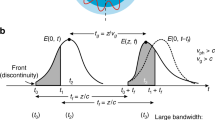Abstract
The aim of this paper is to extend the method of Ammari et al. (Commun. Math. Phys., 2012) to scattering problems. We construct very effective near-cloaking structures for the scattering problem at a fixed frequency. These new structures are, before using the transformation optics, layered structures and are designed so that their first scattering coefficients vanish. Inside the cloaking region, any target has near-zero scattering cross section for a band of frequencies. We analytically show that our new construction significantly enhances the cloaking effect for the Helmholtz equation.
Similar content being viewed by others
References
Abramowitz, M., Stegun, I.A.: Handbook of Mathematical Functions. New York: Dover Publications, 9th edition, 1970, pp. 365–366
Alú A., Engheta N.: Achieving transparency with plasmonic and metamaterial coatings. Phys. Rev. E 72, 106623 (2005)
Alú A., Engheta N.: Cloaking and transparency for collections of particles with metamaterial and plasmonic covers. Optics Express 15, 7578–7590 (2007)
Ammari, H., Ciraolo, G., Kang, H., Lee, H., Milton, G.: Spectral theory of a Neumann-Poincaré-type operator and analysis of cloaking due to anomalous localized resonance. submitted, available at http://arxiv.org/abs/1109.0979v2 [math.AP], 2012
Ammari H., Garnier J., Jugnon V., Kang H., Lee H., Lim M.: Enhancement of near-cloaking. Part III: Numerical simulations, statistical stability, and related questions. Contemp. Math. 577, 1–24 (2012)
Ammari, H., Kang, H.: Polarization and Moment Tensors with Applications to Inverse Problems and Effective Medium Theory, Applied Mathematical Sciences, Vol. 162, New York: Springer-Verlag, 2007
Ammari H., Kang H.: Boundary layer techniques for solving the Helmholtz equation in the presence of small inhomogeneities. J. Math. Anal. Appl. 296, 190–208 (2004)
Ammari, H., Kang, H., Lee, H., Lim, M.: Enhancement of near cloaking using generalized polarization tensors vanishing structures. Part I: The conductivity problem. Commun. Math. Phys., 2012. doi:10.1007/s00220-012-1615-8
Born, M., Wolf, E.: Principles of Optics: Electromagnetic Theory of Propagation, Interference and Diffraction of Light, 6th edition. Cambridge: Cambridge University Press, 1997
Colton, D., Kress, R.: Inverse Acoustic and Electromagnctic Scaftering Theory. Berlin: Springer, 1992
Bryan K., Leise T.: Impedance Imaging, inverse problems, and Harry Potter’s Cloak. SIAM Rev. 52, 359–377 (2010)
Greenleaf A., Kurylev Y., Lassas M., Uhlmann G.: Approximate quantum cloaking and almost trapped states. Phys. Rev. Lett. 101, 220404 (2008)
Greenleaf A., Kurylev Y., Lassas M., Uhlmann G.: Full-wave invisibility of active devices at all frequencies. Comm. Math. Phys. 275, 749–789 (2007)
Greenleaf A., Kurylev Y., Lassas M., Uhlmann G.: Cloaking a sensor via transformation optics. Phys. Rev. E 83, 016603 (2011)
Greenleaf A., Kurylev Y., Lassas M., Uhlmann G.: Approximate quantum and acoustic cloaking. J. Spectral Theory 1, 27–80 (2011)
Greenleaf A., Kurylev Y., Lassas M., Uhlmann G.: Cloaking devices, electromagnetic wormholes, and transformation optics. SIAM Rev. 51, 3–33 (2009)
Greenleaf A., Lassas M., Uhlmann G.: On nonuniqueness for Calderon’s inverse problem. Math. Res. Lett. 10, 685–693 (2003)
Guevara Vasquez F., Milton G.W., Onofrei D.: Active exterior cloaking for the 2D Laplace and Helmholtz Equations. Phys. Rev. Lett. 103, 073901 (2009)
Guevara Vasquez F., Milton G.W., Onofrei D.: Broadband exterior cloaking. Optics Express 17, 14800–14805 (2009)
Kohn R.V., Onofrei D., Vogelius M.S., Weinstein M.I.: Cloaking via change of variables for the Helmholtz equation. Comm. Pure Appl. Math. 63, 973–1016 (2010)
Kohn, R.V., Shen, H., Vogelius, M.S., Weinstein, M.I.: Cloaking via change of variables in electric impedance tomography, Inverse Problems, 24, article 015016 (2008)
Lassas M., Zhou T.: Two dimensional invisibility cloaking for Helmholtz equation and non-local boundary conditions. Math. Res. Lett. 18, 473–488 (2011)
Leonhardt U.: Optical conforming mapping. Science 312, 1777–1780 (2006)
Liu H.: Virtual reshaping and invisibility in obstacle scattering. Inverse Problems 25, 044006 (2009)
Milton G., Nicorovici N.A.: On the cloaking effects associated with anomalous localized resonance. Proc. R. Soc. A 462, 3027–3059 (2006)
Milton G., Nicorovici N.A., McPhedran R.C., Podolskiy V.A.: A proof of superlensing in the quasistatic regime, and limitations of superlenses in this regime due to anomalous localized resonance. Proc. R. Soc. A 461, 3999–4034 (2005)
Nguyen H.M.: Cloaking via change of variables for the Helmholtz equation in the whole space. Comm. Pure Appl. Math. 63, 1505–1524 (2010)
Pendry J.B., Schurig D., Smith D.R.: Controlling electromagnetic fields. Science 312, 1780–1782 (2006)
Taylor, M.E.: Partial Differential Equations II. Qualitative Studies of Linear Equations. Appl. Math. Sci., Vol. 116, New York: Springer-Verlag, 1996
Tretyakov S., Alitalo P., Luukkonen O., Simovski C.: Broadband electromagnetic cloaking of long cylindrical objects. Phys. Rev. Lett. 103, 103905 (2009)
Urzhumov Y.A., Kundtz N.B., Smith D.R., Pendry J.B.: Cross-section comparisons of cloaks designed by transformation optical and optical conformal mapping approaches. J. Opt. 13, 024002 (2011)
Watson, G.N.: Theory of Bessel Functions, 2nd edition, Cambridge: Cambridge University Press, 1944
Author information
Authors and Affiliations
Corresponding author
Additional information
Communicated by S. Zelditch
This work was supported by ERC Advanced Grant Project MULTIMOD–267184 and National Research Foundation through grants No. 2009-0085987, 2010-0017532 and 2010-0004091.
Rights and permissions
About this article
Cite this article
Ammari, H., Kang, H., Lee, H. et al. Enhancement of Near-Cloaking. Part II: The Helmholtz Equation. Commun. Math. Phys. 317, 485–502 (2013). https://doi.org/10.1007/s00220-012-1620-y
Received:
Accepted:
Published:
Issue Date:
DOI: https://doi.org/10.1007/s00220-012-1620-y



